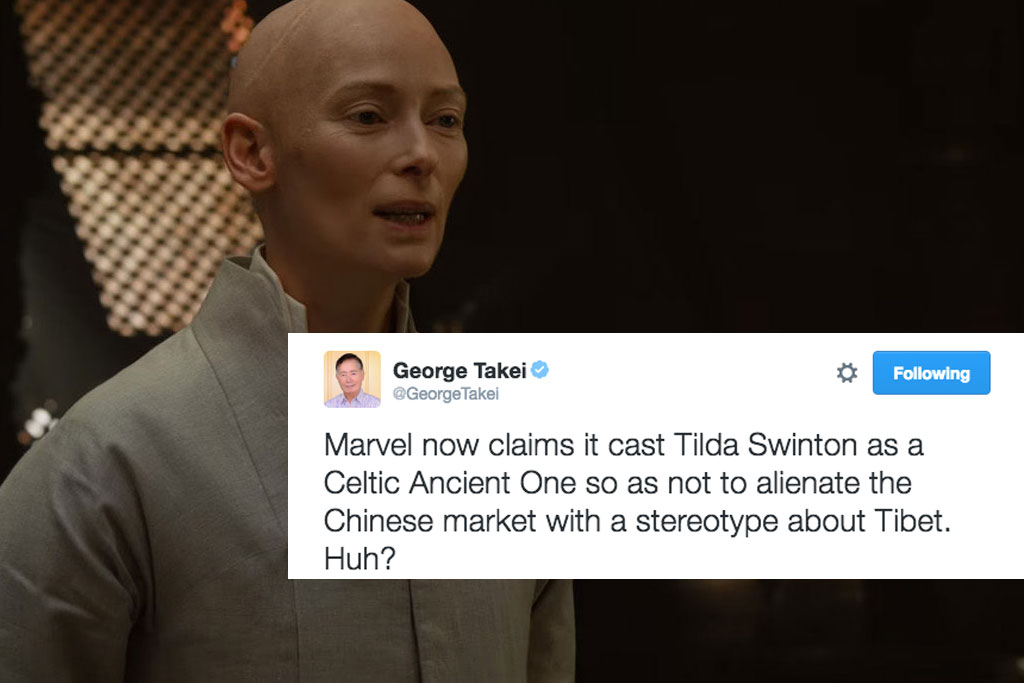People On Twitter Are Mad About Hollywood’s Whitewashing (But Australia Isn’t Much Better)
Tilda Swinton's casting in Doctor Strange was the catalyst, but it's not the only example.

Overnight, comedian Margaret Cho and website Nerds of Colour led a Twitter discussion about the ‘whitewashing’ of Hollywood and its lack of representation for Asian American communities. The hashtag #whitewashedOUT, which is still trending, was also buoyed by a blog by George Takei criticising the casting of Tilda Swinton as the Ancient One in Doctor Strange, a character who in the comics comes from Tibet.
The conversation on Twitter revolved around the long tradition of Hollywood mostly casting POC as sidekicks.
Those who say racism doesn't exist anymore are the biggest perpetuators of it #whitewashedOUT
— Margaret Cho (@margaretcho) May 3, 2016
Not a sidekick. Not a sidechick. #whitewashedOUT
— Margaret Cho (@margaretcho) May 3, 2016
It's intense. It's that we have been invisible for so long we don't even know what we can do. https://t.co/uNvgShyFcM
— Margaret Cho (@margaretcho) May 3, 2016
instead of trying to crash a party i'm not wanted at, i'd rather have a gathering you are all welcome to.#whitewashedOUT
— beau sia (@BeauSia) May 3, 2016
You can't even say people are doing this out of ignorance anymore! They've been told existing media is not getting it done. #whitewashedOUT
— Nicole Chung (@nicole_soojung) May 3, 2016
The erasure of Asian characters in Hollywood film has always been an issue, but it seems to have attracted more notice of late. The casting of Scarlett Johansson as Major Motoko Kusanagi in the live-action remake of Ghost in the Shell was described by some, like Fresh Off The Boat‘s Constance Wu, as “yellowface”, particularly when it was revealed that the film producers were testing out “race-bending affects” on her. Margaret Cho has also called out the upcoming Absolutely Fabulous movie for employing yellowface in the depiction of a Japanese character called ‘Huki Muki’ who is played by a white, Scottish woman.
#YELLOWFACE is racism. Sorry. It's unacceptable. Not now. I was thrilled about #abfabmovie but now I just can't be. I'm very disappointed.
— Margaret Cho (@margaretcho) December 14, 2015
Recently there was similar disappointment at the casting of blue-eyed blonde-haired Finn Jones in the role of a Kung-Fu master in Marvel’s Iron Fist (the character was originally white, but many critics felt the casting was a missed opportunity to hire an Asian actor).
We can't have #AAIronFist but a Celtic Ancient One is ok because 'canon' doesn't matter unless the character is white. #whitewashedOUT
— The Nerds of Color (@TheNerdsofColor) May 3, 2016
In today’s Lenny Letter Oscar winner Lupita Nyong’o has also written about the limited roles offered to women of colour. Although she is often used as an example of Hollywood’s erasure, since winning her Oscar she has mostly been playing CGI aliens and animals (The Force Awakens, Jungle Book), she says that these roles were “cathartic” because at least they were something different.
“So often women of colour are relegated to playing simple tropes: the sidekick, the best friend, the noble savage, or the clown,” she writes. “We are confined to being a simple and symbolic peripheral character — one who doesn’t have her own journey or emotional landscape”.
Wait, Lupita was that alien chick? https://t.co/A3VfXiQ94b
— The Kid (@LikeMike131) April 28, 2016
This may be happening in the U.S, but we shouldn’t be smug; the same issues still apply to Australian film and TV. In the last year shows like The Family Law and Ready For This (and soon, Cleverman) have offered an alternative to stories about white 16-year-olds running around Summer Bay or quirky white people negotiating relationship dramas, but these are still only exceptions. A handful of shows won’t ‘fix’ Australian TV’s diversity problem — I mean, the fact that Heartbreak High, which debuted in 1994, is still one of Australia’s most diverse shows to date, is pretty ridiculous.

I mean…
The uproar over Waleed Aly and Lee Lin Chin’s Logies nominations makes it clear that some old bigots are very resistant to changing anything about the pervasive misrepresentation in Australian pop culture. When writing about diversity and Australian TV last year, Junkee writer Shaad D’Souza said: “Hopefully the success of programs such as Master of None and The Slope, as well as international hits such as Fresh Off the Boat and Empire, will encourage Australian networks to take notice of people of colour working in television, too. But ultimately, it may be up to viewers to push for a change.”
How long until this #whitewashingOUT movement reaches Australia?
–